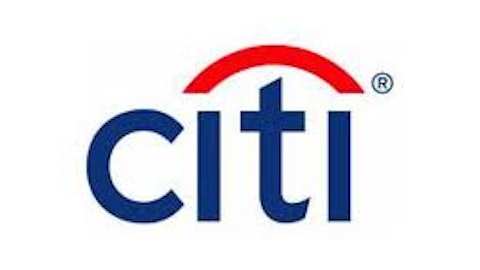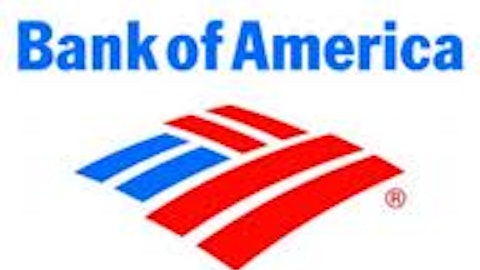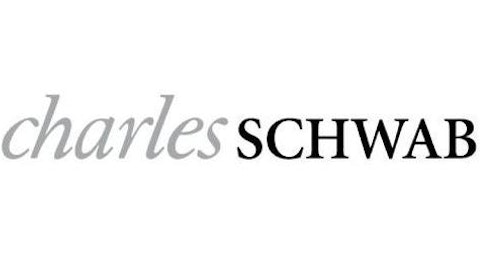![]() Over the past month, all 10 sectors on the S&P have ridden the wave of a rising market higher. But with a 6.7% gain, the financial sector has been one of the best performers as group.
Over the past month, all 10 sectors on the S&P have ridden the wave of a rising market higher. But with a 6.7% gain, the financial sector has been one of the best performers as group.
Breaking this statistic down further, within the financial sector, banking stocks are particularly hot with Bank of America Corp (NYSE:BAC) as a clear winner among banks.
While behemoths Wells Fargo & Co (NYSE:WFC) and JPMorgan Chase & Co. (NYSE:JPM) have each risen about 7% in the past month, Bank of America Corp (NYSE:BAC) has more than doubled that performance, increasing nearly 16% over the same period.

With management working to stabilize revenue streams, strengthen the balance sheet and contain costs, Bank of America Corp (NYSE:BAC) — which is expected by some analysts to grow earnings 18% annually for the next 10 years — should continue to see strong growth ahead.
From a technical perspective, the chart appears bullish.

Over the past two and a half years, shares have had a 360 degree turnaround.
At the beginning of 2011, the stock peaked at $14.95 then quickly fell, dropping 67% by year’s end to a low of $4.89. It has since recovered all the ground previously lost. The stock closed Aug. 1, 2013 at exactly $14.95!
In early 2012, shares bounced strongly off the $4.89 bottom. The stock hit a March 2012 peak of $10.05, but encountered historical resistance and sank again.
By May 2012, shares had fallen to $6.68. Shares again fell to about this level in July 2012, forming a W-shaped base.
The formation was predictive of higher prices, and the stock steadily climbed off the $6.87 secondary low and broke the major downtrend line.
Since the fall of 2012, shares have been climbing a major uptrend line higher. In late 2012, shares successfully pierced $10.90 resistance.
For much of early 2013, the shares hovered just above $10.90, which acted as important support. Since June, the stock has again moved sharply higher.
During the last trading week in July, shares hit a multi-year high of $15.03. Shares are currently trading just below this high, at $14.95, and if the stock can once again penetrate and hold $14.95 resistance, it could soar.
The next logical target would be round number resistance at $20. This target represents over 33% returns.
The moving averages support the bullish outlook. The rising 50-day moving average (blue) appears on the verge of bullishly crossing above the flat 150-day moving average (red). Should this crossover occur, it would create a bullish technical signal similar to the “golden cross” (when the 50-day crosses above the 200-day).
The upbeat technical outlook is supported by strong fundamentals.
For the upcoming third quarter, scheduled to be reported Oct. 14, analysts suspect increased transactions will push revenue to $22.3 billion, a 9.2% gain compared to revenue of $20.4 billion in the year-earlier quarter.
For the full 2013 year, analysts project revenue will increase 5% to $90.7 billion from $86.3 billion last year.
The earnings outlook is also solid.
Because of continued improvement in investment and brokerage income and increased banking fees, analysts estimate third-quarter earnings will reach $0.20 per share from $0.00 in the year-earlier period.
For the full 2013 year, analysts anticipate these growth drivers will contribute to a whopping 268% gain, with earnings reaching $0.92 per share from $0.25 per share last year.
In addition, the company appears attractively valued based on its five-year PEG ratio (price to earnings divided by growth rate) of 0.86. In general, a PEG ratio of 1 or under shows a stock that is attractively priced.
Risks to consider: Mortgage rates remain near historical lows, but could rise as the economy recovers. Higher rates could decrease mortgage lending volumes, potentially impacting profits at the bank. However, the consensus is interest rates will be stable until at least 2015 and possibly later.
Recommended Trade Setup:
— Buy BAC at or above $15.04
— Set stop-loss at $12.89, slightly below support
— Set price target at $19.95 for a potential 33% gain in four months
$1,000 Per Month Trading System
You could collect $1,000 or more per month without buying a single stock. Click here to learn how…



